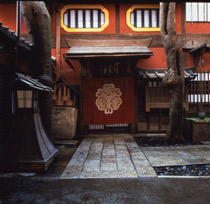

 The Architecture of Sumiya The Architecture of Sumiya
 Sumiya
is a frame, two story building roofed with tile,copper plates and
shingles. It has three main parts: the lattice work exterior
and entry way, the huge, open kitchen,and the interior rooms. Its
floor space is 1,119 m2 and
its site measures 2,483 m2.
It is the finest extant example of Edo Period (l603-1868) ageya
architecture. Sumiya
is a frame, two story building roofed with tile,copper plates and
shingles. It has three main parts: the lattice work exterior
and entry way, the huge, open kitchen,and the interior rooms. Its
floor space is 1,119 m2 and
its site measures 2,483 m2.
It is the finest extant example of Edo Period (l603-1868) ageya
architecture.
An ageya was an elegant restaurant where banquets and
dinner parties were held accompanied by the entertainment
of geisha and taiyu (premiere geisha), who performed tea
ceremonies, sang and danced. The geisha and taiyu lived and
were employed at establishments called okiya from where
they were summoned to the ageya.
Sumiya is a surviving masterpiece of the ageya architectural
style. In 1952 it was designated by the government of Japan
an Important Cultual Property. The ageya architectural style
combines shoin-tsukuri and sukiya-tsukuri features. Shoin-tsukuri
is the elegant, formal style of the warrior class,featuring spacious
rooms, elaborate carving and beautifully
painted walls and sliding doors. The sukiya-tsukuri is the
delicate, informal style of the tea ceremony room, using
materials in their natural state and subtle, informal refinement.
Ageya architecture was a creation of the rising class of urban merchants and
artisans: plain on the exterior but
sumptuous within, elegant and spacious like palaces of the
samurai, but refined and casual like tea rooms.
 The History of Sumiya The History of Sumiya
The Nakagawa family has owned and managed sumiya for
13 generations, since 1641. In 1641 the entire Shimabara
entertainment district including Sumiya, was ordered by the
Shogun to move from its former site at Roku-jo-misuji-machi, Kyoto,
to its present location. In 1787 Sumiya was expanded to about its
present scale.
 The Cultural and Historical Significance of Sumiya The Cultural and Historical Significance of Sumiya
Because of its location in what was once the entertainment
district of old Kyoto, Sumiya is sometimes seen only as an
example of the decadent amusements of a former age. This
view is short sighted. Sumiya was not merely a house of
entertainment but functioned as a meeting place and cultural
salon where famous men in the fields of art, literature and
politics gathered. And because there are no surviving play
houses or other similar structures in Tokyo, Osaka or Kyoto,Sumiya
is the finest extant example of Edo Period popular
urban culture of the merchants and artisans.Compared to the many
surviving examples of temple and
palace architecture of the elite classes, the interiors of
Sumiya surprise us with their freshness and originality. Here
the tastes and style of the city dwelling shopkeepers and
tradesmen was emerging onto the stage of history. We can
still sense its vigor and creativity after 300 years.
Sumiya also figures prominently in several phases of Edo
Period artistic and political history. Its sliding paper doors
and folding screens are decorated by some of the greatest
artists of the Mid-Edo Period, such as Yosa Buson (l716-84),Maruyama
Okyo, Kishi Ganku (1756-1836), Yamada Gazan
and Emura Shumpo. Among these works is the famous
National Treasure, "Plum Blossoms", by Buson.
At that time Sumiya was also a meeting place of the
well-known haiku group called Shimabara Haidan (haiku
are seventeen syllable Japanese poems). The sixth and seventh generation
proprietors of Sumiya were friends of Buson, Taigi and other notable
haiku poets of the era and
collected the works of these masters. Many of these masterpieces
are still preserved in Sumiya's archives.
The historical significance of Sumiya is not limited to these
examples. During the final years of the Edo Period the
well-known political reformers Sakamoto Ryoma (1836-67),
Saigo Takamori (1827-77), and Kusaka Genzui (1840-64)
invited the rich merchants Konoike and Kashimaya to
Sumiya in order to raise funds to restore the Emperor to
power.
With this rich heritage in mind, we hope you will be able
to appreciate better Sumiya's significance for Japan's history
and culture.
SUMIYA
32 Banchi, Ageya-cho, Shimogyo-ku, Kyoto, Japan |



